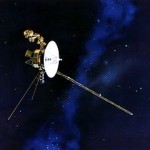
Voyager 2
Voyager 2 was launched in 1977. It traveled near Jupiter in 1979, Saturn in 1981, Uranus in 1986, and Neptune in 1989. It transmitted photographs and data back to earth. It continues in its space travels, sending back weak radio signals. Children can visit an INTERESTING website, including data on the spacecraft’s distance from earth, at: Voyager 2.

